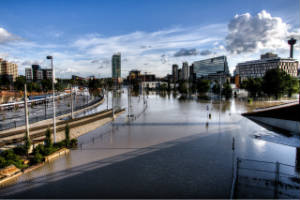
It’s amazing how invisible climate change can be – how we feel immune from the consequences of what seems like a vague, global challenge. We think that climate change only occurs in far off climate-vulnerable nations. Which is why some may be surprised that Canada’s Parliamentary Budget Officer predicts that extreme weather events will cost Canadians $4.92 billion each year between now and 2020, much of that due to climate change.
Oddly, the $4.92 billion price tag, based on projections by the Insurance Bureau of Canada, was largely unmentioned in media coverage (see, for example, the Globe and Mail or the Canadian Press stories), which instead focused on whether the federal government’s Disaster Financial Assistance Arrangement (DFAA) has budgeted enough to pay its $902 million per year share of that cost.
The stories did make note of Frechette’s conclusion that climate change was a significant factor in the increase in weather related damages, but did not emphasize the magnitude of the impact that we’re talking about. This graph shows how the DFAA payments (converted into 2014 dollars) have grown over 50 years (including his projection for the coming 5 years).

Now not all of that is due to climate change – Frechette notes that much of it is due to development in floodplain areas and other bad (non-climate resilient) ideas. But it seems likely that a major portion is. The $4.2 Billion figure does not include wildfires, and it does not include a host of other climate-related impacts and expenses that are unrelated to extreme weather.
The 2010 report of the National Roundtable on Environment and Economy, Paying the Price, estimated that by 2020 Canada’s economy would experience $5 Billion in climate-related losses per year, and it looks as if they may not be far off (if they haven’t underestimated the economic impact).
Meanwhile, there is reason to believe that costs will rise more in the future. A report from the Potsdam Institute for Climate Impact Research, released after the PBO report, concluded that relatively small increases in sea-level can cause dramatic impacts:
“When sea levels rise, damage costs rise even faster, our analyses show,” explains Markus Boettle, lead author of the study published in the journal Natural Hazards and the Earth System. Rising sea levels as a major impact of climate change pose a risk for coastal regions – the mean regional sea level rise takes effect by more frequent and more intense coastal flood events.
As we’ve noted before, Canada’s last Prime Minister was known for saying that climate action should not harm Canada’s economy, when it’s pretty clear that climate inaction continues to do so.
Climate vulnerability v. climate impacted
Image of typhoons in the Philippines and Vanuatu are what many think of when we hear about climate impacts. These nations are “climate vulnerable” we are told. But the fact that we are not climate vulnerable doesn’t mean that we are not climate-impacted. We are not considered climate vulnerable because we (for the most part) have the resources to build buildings and infrastructure that are resilient to extreme weather and other climate impacts, and we have the resources (including through the DFAA) to rebuild or relocate when climate disaster strikes.
Imagine what it must be like for countries that don’t have $4.2 Billion (and rising) to spend on disaster recovery, and who also suffer disproportionately because of the lower resilience of their infrastructure and buildings.
A couple additional points here. First, while Canada, as a whole, is not considered climate vulnerable, some Canadian provinces are less resilient to climate impacts than others. Frechette’s report notes that most of the flood damage comes from Alberta, Saskatchewan and Manitoba, and suggests that poor regulation of development in flood plains may be in part to blame. As well, there are also aspects of social vulnerability that need to be considered, and the likelihood that some Canadians are much more vulnerable than others.
Second, it is important to consider whether these costs should be solely absorbed by climate impacted communities and/or taxpayers. Do fossil fuel companies having made billions selling products that they knew would cause this type of impact, and concealing that information, have a responsibility to pay for some of it? Does the developed world having built its economies, and its resilience to climate change, on cheap energy from fossil fuel, have the obligation to help truly climate vulnerable countries?
Conclusion
If anyone thinks that the fossil fuel industry is an unquestioned good for our economy, and will continue to be, they are probably only reading one side of the balance sheet. The economic costs due to our fossil fuel habit are rising, while the economic benefits of sticking to fossil fuel are decreasing as renewables and electric vehicles become more affordable.
We are already paying the price for the fossil fuel economy, while the companies that push fossil fuels are not.
By Andrew Gage, Staff Counsel
Photo by Ryan L.C. Quan under the Creative Commons Attribution-Share Alike 3.0 unported licence (obtained from Wikimedia Commons).
Update: An earlier version of this post mistakenly put the extreme weather loss at $4.2 billion. The actual number in the report is $4.92 billion. This post was updated on 29 March 2016 to include the correct figure.